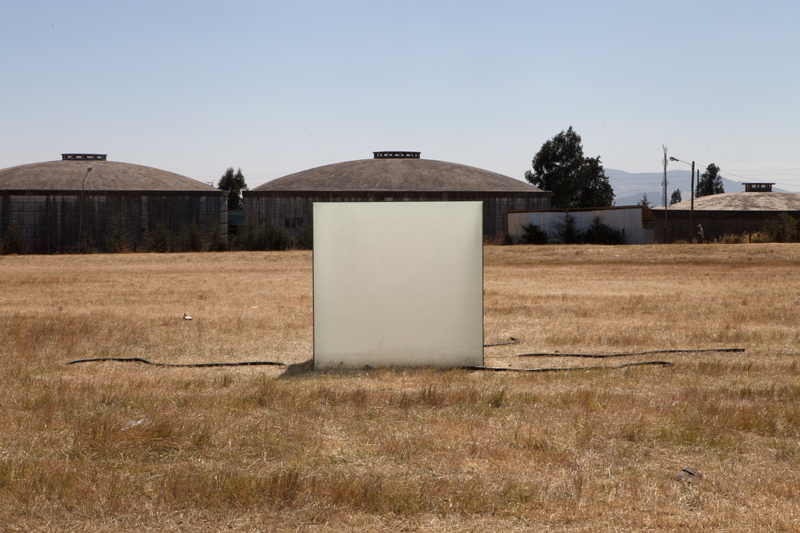Markus Hoffmann studied fine arts at Universität der Künste, Berlin in the Instiut für Raumexperimente founded by Prof. Olafur Eliasson. Prior to UdK, Hoffmann studied medicine at Charité Berlin. Addressing notions of time, place, personal history and collective memory, Markus Hoffmann focuses on viewers’ capacities to relate to their surroundings and the boundaries or limits that come with this relation. His work encompasses a versatile spectrum of media spanning from conceptual photography to time-based sculpures and installations. Based in scientifc reference systems, his works oscillate between art, science, and architecture. Hoffmann’s projects are shown internationally and have been supported by awards, grants, and residencies.
Markus Hoffmann is a founding Member of Das Numen Collective and and is specifcally known for his continous and deep 10 Year of ongoing research and artworks on topics related to radioactivity, nuclear exclusion zones and antropocene realted themes.
In the last years, he as worked alongside and in conversation with topics relating ot the Anthropocene, aiming to combine scienctifc methodologies and the manufacture of new realities to realise works that allow for spatial or individual projection.
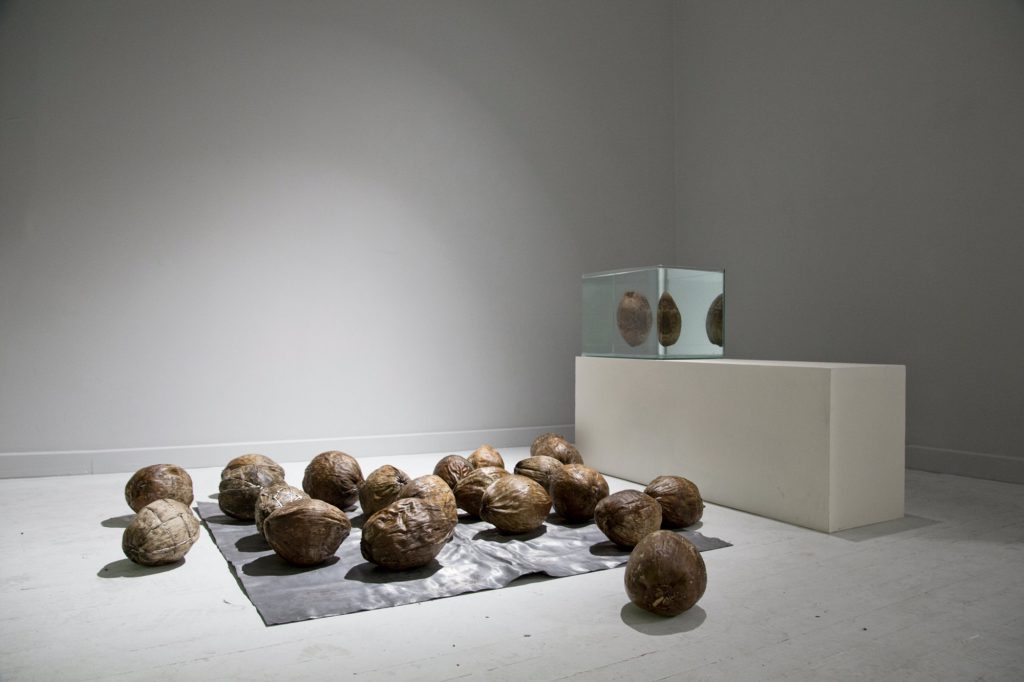
Bikini Atoll Containment II (Equilibrium). Installation. 20 contaminated coconuts from the bikini atoll, wood, glass, lead. Courtesy of Blok Art Space Istanbul and Studio Markus Hoffmann 2016
Marika Marchese: Tell me a bit about your cultural background.
Markus Hoffmann: I am an interdisciplinary trained artist. I always had a favor for perception the perceptive apparatus and memory, its mechanisms and how these elements interact to create what we perceive as reality. I was born in Germany in Passau located near the border of Austria and the Czech Republic. Travelling and exploring remote places has always been a substantial part of my life thus of my artistic practice. My studio is located in Berlin.
M.M.: When did you realize that you wanted to become an artist?
M.H.: Realizing that the artistic contexts supported my contribution to reality I choose to go that path. Being trained as an artist with a scientific background I think there was a was a point when I started to realize that its not what you do, but how you do what you do that matters. Taking in consideration its consequences, its history and its potential that brings you close to the question of how you can focus your approach to reach a state of mind that supports reflective progress as well as the implementation of a poly-perspective way of thinking to be shared and co-produced with others.
M.M.: What were your most important influences that lead you to decide to be an artist?
M.H.: It was the world surrounding me and that basic pounding questions of who I am and what I am going to do best to relate to those questions that where prevalently asked by my inner world and the world I considered as reality that surrounds me. And the fact that one could relate to them in a myriad of ways. So I would say that I was offered to observe the world from different perspectives and that was it. Moreover, I was lucky to be surrounded by books by Goethe, Jules Verne, David Foster Wallace, Vilém Flusser, Robert Smithon, Emmanuel Kant, Gilles Deleuze and Félix Guattari, J. G. Ballard, Stanislav lem and a variety of books from people of the Bauhaus and many others. That surrounding archive in combination with my experiences in nature gave me the idea that you can actually relate to reality in different ways, all beautiful, some more scientific, some more formal, some more analytic somehow descriptive and emotional but all of them containing a genuine beauty making you a responsible co-author of reality. But most important and maybe the biggest present was that I was so lucky to grow up with nature, inside nature, related to nature and its changes, phenomena and textures.
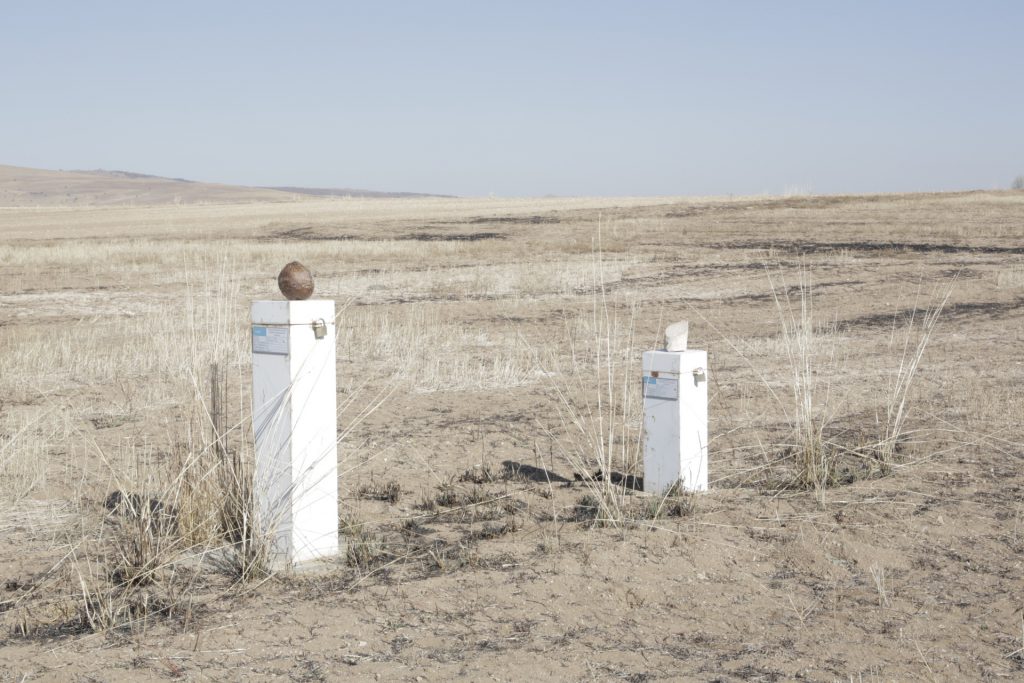
M.M.: Tell me about your process, where things begin, how they evolve?
M.H.: Something unknown, a touching moment, a feeling, a faint pre-concept of a thought in an ocean of possibilities, but some thoughts tend to get very strong that I cannot refuse taking them into reality finding a specific vocabulary and a syntax for them that allow me to articulate them in whatever media. So I would say there is research, a lot of experiments and the experience of specific places that enhance my perceiving – thinking – doing process. As well as all landscapes and places its different layers of sedimented history. I would say my work derives from my strong commitment to experimentally-funded knowledge and their limits; to the creation of and reflection upon new questions; to a longing for the realization of new experiences; and to gnosis as a basis for the production of new art works. I see myself as a cultural co-producer, a future fossil archaeologist with a speculative approach.
M.M.: What does ‘being an artist’ mean to you? Who are your favorite artists and how have they influenced you?
M.H.: To take my thoughts and actions seriously. I think to me to be an Artist means to look at the world from different angles and relate to something that is appealing to you. It means to grow during that journey of coincidences that let you rethink your ultimately limited investment of lifetime and attention. It’s a long list and I do not know if I want to judge or favor one or the other, but for sure people like Roberts Smithon, Marcell Duchamp, Michel Heizer, Steve Reich, John Cage, Marc Rothko, Pierre Huyghe and for sure my mentor and professor Olafur Eliasson were people that influenced my way of relating to the world, each of them in their own way.
M.M.: The scientific element is central in your works. What usually catch your interest?
M.H.: Science is a way to look at and a way to describe reality as well it implements a set of practices like experiments that oscillate quite well with my mindset. I think there is nothing that usually catches my interest, its just some things have specfic combinations of aspects that catch my interest.
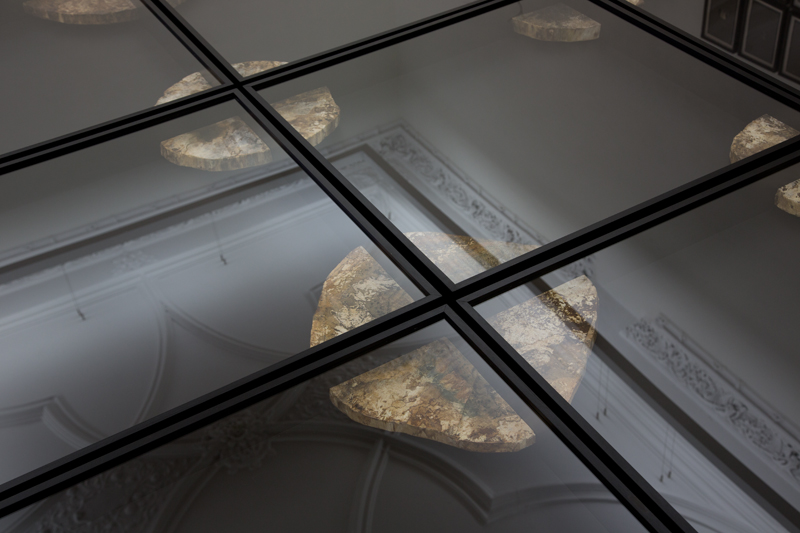
Courtesy of Studio Markus Hoffmann
M.M.: Working closely with an artist like Olafur Eliasson should have been a wonderful experience for you. What was the impact of that collaboration on your artistic career?
M.H.: I had an inspiring time and it was very supportive for my intellectual development to dedicate a period of my lifetime to study at the Institute for Spacial Experiments and to have Olafur Eliasson as a great point of reference, learning and exchanging on ideas and possibilities how to relate de- and re-construct reality.
M.M.: What do you think is the role of an artist in today’s society?
M.H.: There are many roles but I wish whatever specific role an artist chooses it hopefully implements research, collaborations, compassion, a responsibility for others and the environment of the planet and the awareness and the responsibility that everyone’s life is a role model for others to follow. Maybe its still that Kantian question: “Enlightenment is man’s emergence from his self-incurred immaturity.” Kant argues that the immaturity is self-inflicted not from a lack of understanding, but from the lack of courage to use one’s reason, intellect, and wisdom without the guidance of another. I agree and would as well add that nourishing kindness, friendship to support the progress of the developement of others should be an essential element of your self chosen role as well.
M.M.: What subjects do you deal with in your art?
M.H.: “We have reached a tipping point that does not merely consist in the fact that climate change has reached a point where it is self-reinforcing, or that fossil resources are becoming dramatically depleted. Over the last centuries, humankind has put processes in motion leading to developments for which we no longer have any standards by which to judge them. When humankind itself becomes a natural force – or that which we understood to be nature is now made by humans – then the dualism of nature/culture subject/object no longer function in the accustomed fashion.” (Bernd M Scherer Textures of the Anthropocene). In the last years, I have worked alongside and in conversation with topics relating to the Anthropocene, aiming to combine scientific methodologies and the manufacture of new realities to realize works that allow for individual projection. This focus led me to travel to remote places like Chernobyl the Bajan Obo Mine, Fokushima … in order to create experience and exploration driven site specific art works like the Bikini Atoll Containment series. A core of my work orbits around issues of radioactive materials, rare earth minerals and other industrial toxic waste and the changes and recomposition of those landscapes created by the human impact. I would call these fractals of landscapes and the waste products as the guiding fossils of the Anthropocene. As well I also work a lot with different phenomena, questions related to normality and different forms of archives. There is always the central question of representation translation e.g. of a landscape, an experience, a touching moment into an an Artwork that addresses different layers of consciousness. The beauty lies in the translation/transformation on both ends from the idea to the artwork and the viewer that makes the artwork a subjective experience. I am very interested in the specificity of that translation/transformation.
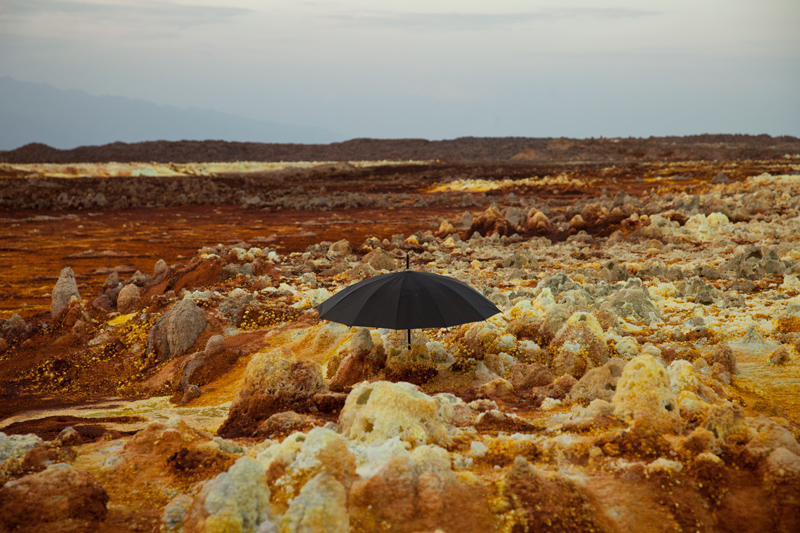
Acid rain, 2012. Installation. 3 Fine Art Prints. Sulfuric acid corroded umbrella, sulfur.
Courtesy of Studio Markus Hoffmann and Collection Hoffmann
M.M.: How has your work developed throughout the years?
M.H.: I realize more and more that I am working on a visual vocabulary and different perspectives that implement moments that touched me on an experiential level.
Implementing that quality, the “quality of a touching moment“ and translating/transforming it in my work allows the viewer to be part of the artwork.
This idea of creating a potential for individual projections and narratives based on the viewers individual history and experience related to a global context at that moment of time is a reocurring question that re-phrased itself in many ways. But to get a full picture I think its more honest to suggest that you have a look and experience the works.
M.M.: Tell me about Invisible Imprint II, what’s the spark of this artwork?
M.H.: Like Invisible Imprint II, Inverted Invisible Imprint uses the technique of an autoradiographic process and symbolically references the sun.
However, this work leaves a blank white circular field – like a traumatic blind spot created on the retina by staring at the sun, you are invited to see the periphery but the center seems to be lost. The green shadows were created with radioactive material from every active, major uranium mine on the planet.
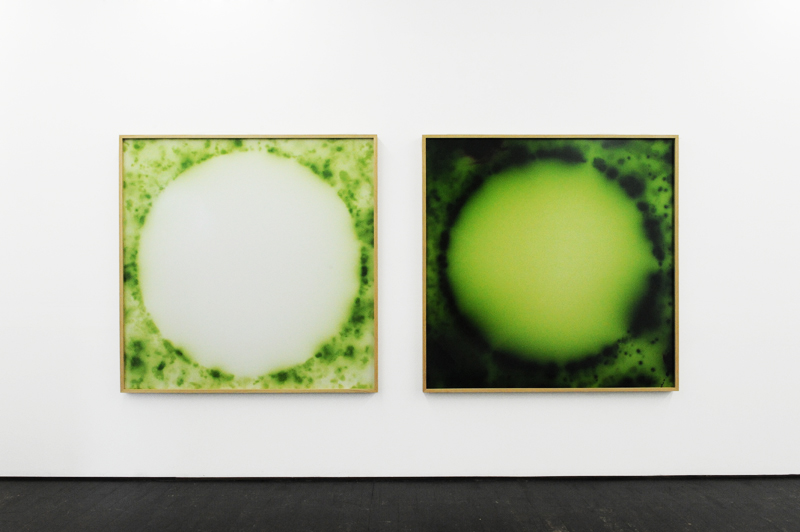
Courtesy of Studio Markus Hoffmann and Nosbaum Reding
M.M.:Is there a connection with Zirkon Compass?
M.H.: Filled with different zircon sands from all the continents of the world, the work Zircon Compass consists of sixteen hourglasses that are suspended from the ceiling. Yes, I would say both works invisible imprint and Zircon compass deal with themes of time, the anthropocene, exposure and the non perceivable. They are also connected material wise because radioactive material plays its part in both work attempts. Positioned at eye level, the hourglasses are arranged in a circle, each situated at one of the directions of a 16-point compass rose. A thin steel rope is attached to the narrowest point of each hourglass, balancing them in a horizontal equilibrium. Zircon minerals are the oldest known materials on Earth. Resistant to chemical changes, they offer a window in time as far back as 4.4 billion years ago. Zircon is present in every stone on the planet, and it contains the radioactive elements uranium and thorium in trace amounts – the decay of these elements forms the clock within the zircon. With the passing of time, uranium and thorium convert to the element lead. In the work, both the semiotics of the hourglass as a metaphor for vanitas and the use of the hourglass as a scientific instrument are transformed. Here, the sand forms a seemingly stable horizon: a layer, the oldest layer we could hypothetically stand on. While the hourglass has thus lost its function, the zircon clock invisibly continues to transform; silently reminding the viewers of their precious and transient time on earth. The zircon keeps time: as the oldest material on the planet, it establishes an abstract meaning of time that is limited by our current possibilities of scientific research. It thus inherently addresses the relative stability of scientific knowledge, which depends on technological progress and the creation of measurement methods, which enable us to expand our ever-limited horizon. Paradoxically zircon is used to create storage vessels that might be durable enough to contain the radioactive waste products of our species – the future fossils of the Anthropocene. But the zircon is not eternally stable. Everything eventually decays.
M.M.:Can you talk about Acid rain? Why this subject? How do the atmospheric/naturalistic aspects of the place affect your research?
M.H.: I think Acidification its one of the relevant themes seriously harassing and threatening our environment on different levels. Acid rain is a rain or any other form of precipitation that is unusually acidic, meaning that it possesses elevated levels of hydrogen ions (low pH). It can have harmful effects on plants, aquatic animals and infrastructure. Acid rain is caused by emissions of sulfur dioxide and nitrogen oxide, which react with the water molecules in the atmosphere to produce acids. Acid rain has been shown to have adverse impacts on forests, freshwaters and soils, killing insect and aquatic life forms, causing paint to peel, corrosion of steel structures such as bridges, and weathering of stone buildings and statues as well as having impacts on human health.
I guess it was the landscape of the desert itshelf that was calling for this artwork. It was done in a mood of passage/transience like a short rain shower because I was actually there because I was on my way to the Ertaale Vulcano to do the work Ertaale.
That makes the work a fainth site specific comment of my relatedness to the landscape. The Danakil Desert is located in the triangle of Ethiopia, Eritrea and Djibouti. With its deepest point about 110 meters below sea level Danakil is one of the hottest and driest deserts in the world. Due to some findings of 3,2 million year old fossils the region is referred to as “The hell hole of Creation” or “The cradle of mankind”. In the work Acid rain an umbrella is set up in the middle of the desert and being poured over with acid sulfur. The gesture recall thesources and the consequences of acid rain and implies a certain fragility of the vital existence. It’s a phenomenon reaching out for transnational responsibility effecting life around the globe. The paradox being that humankind might have had its origin in the Danakil desert and that it barely rains there implicitly tells a speculative story of a time where rain, although necessary, has become a thread instead of a blessing. This associates the work with an uncanny forecast for the future to come.
M.M.: What are you working on at the moment?
M.H.: I am working on two upcoming participations in shows: one at the Kunsthaus Wien and one at the Spengel Museum in Hannover.
Furthermore, i just finished some long time exposure series of autoradiographies that are related to my work research on the nuclear contaminated Bikini Atoll that started in 2015 (Coral memory / Nucifera Metamorphosis). As well as I finished a film project called Bikini Atoll Containment. Elephant Forrest Emergence, that was shot in Chernobyl and is on display in Kiev right now. Additionally, I am planning my next journey to China.


